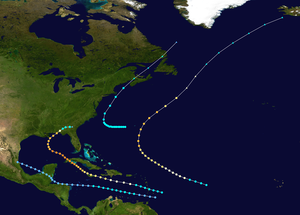| 1917 Atlantic hurricane season | |
|---|---|
 Season summary map | |
| Seasonal boundaries | |
| First system formed | July 6, 1917 |
| Last system dissipated | October 20, 1917 |
| Strongest storm | |
| Name | "Nueva Gerona" |
| • Maximum winds | 150 mph (240 km/h) (1-minute sustained) |
| • Lowest pressure | 928 mbar (hPa; 27.4 inHg) |
| Seasonal statistics | |
| Total depressions | 9 |
| Total storms | 4 |
| Hurricanes | 2 |
| Major hurricanes (Cat. 3+) | 2 |
| Total fatalities | 76 total |
| Total damage | $170,000 (1917 USD) |
| Related articles | |
The 1917 Atlantic hurricane season featured nine known tropical cyclones, four of which became tropical storms.[1] The first system appeared on July 6 east of the Windward Islands. After crossing the islands and traversing the Caribbean Sea, the storm struck Honduras, Belize, and Mexico, before dissipating on July 14. After more than three weeks without tropical cyclogenesis, another tropical storm developed west of Bermuda. As the storm brushed eastern New England, four ships sank near Nantucket, causing 41 fatalities. The same cyclone brought damaging winds to Nova Scotia before transitioning into an extratropical cyclone on August 10.
A hurricane developed over the central Atlantic Ocean on August 30 and ultimately affected Bermuda with heightened tides as it passed to the east. Elsewhere, the hurricane had little impact, becoming extratropical on September 5. After the third system, a series of four tropical depressions formed, but failed to become severe. The fourth hurricane brought devastation to Jamaica, Cuba, and portions of the Gulf Coast of the United States, especially western parts of the Florida Panhandle. Overall, the storm left six deaths and inflicted at least $170,000 (1917 USD) in damage.
The season's activity was reflected with an accumulated cyclone energy (ACE) rating of 61,[2] slightly above the 1911–1920 average of 58.7.[3] ACE is a metric used to express the energy used by a tropical cyclone during its lifetime. Therefore, a storm with a longer duration will have high values of ACE. It is only calculated at six-hour increments in which specific tropical and subtropical systems are either at or above sustained wind speeds of 39 mph (63 km/h), which is the threshold for tropical storm intensity. Thus, tropical depressions are not included here.[2]
- ^ Cite error: The named reference
documentationwas invoked but never defined (see the help page). - ^ a b Atlantic basin Comparison of Original and Revised HURDAT. Hurricane Research Division; Atlantic Oceanographic and Meteorological Laboratory (Report). Miami, Florida: National Oceanic and Atmospheric Administration. September 2021. Retrieved October 1, 2021.
- ^ Landsea, Christopher W.; et al. (May 15, 2008). "A Reanalysis of the 1911–20 Atlantic Hurricane Database" (PDF). Journal of Climate. 21 (10). Miami, Florida: National Oceanic and Atmospheric Administration: 2146. Bibcode:2008JCli...21.2138L. doi:10.1175/2007JCLI1119.1. S2CID 1785238. Retrieved September 6, 2021.